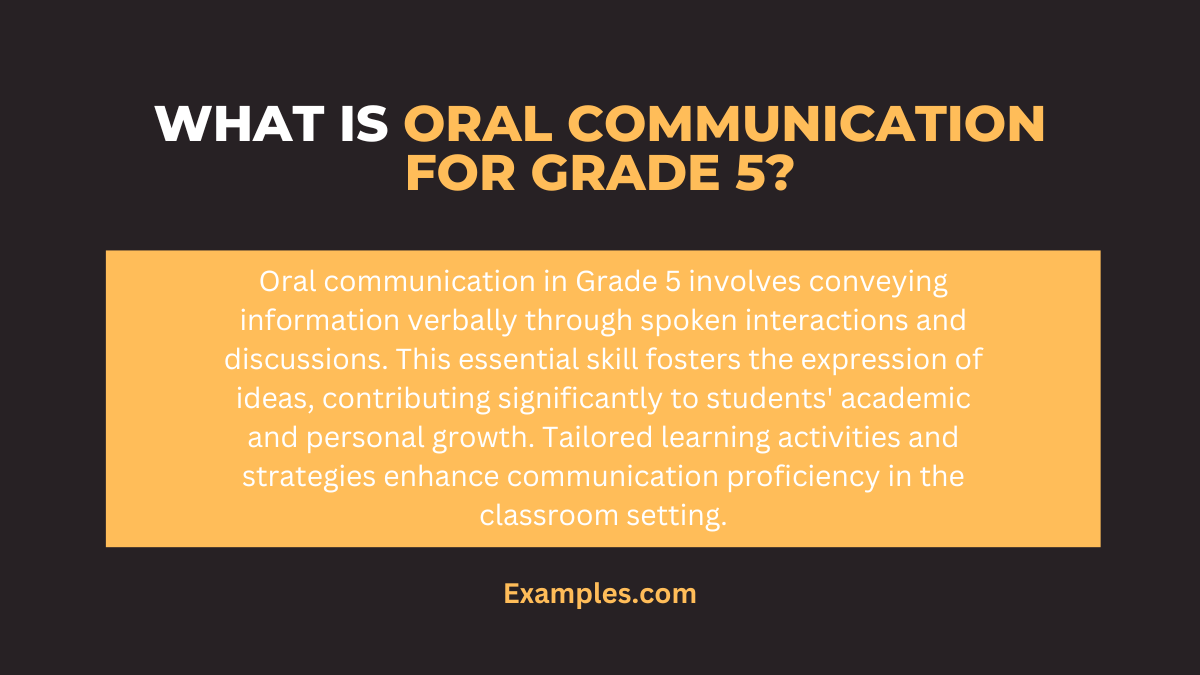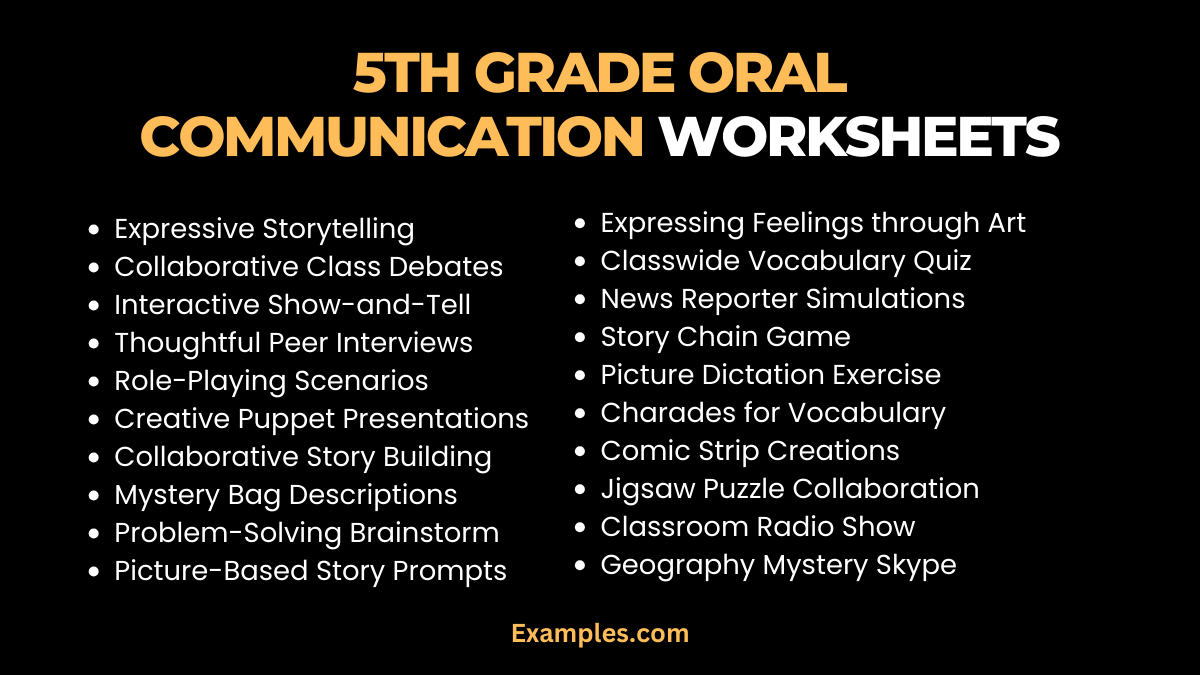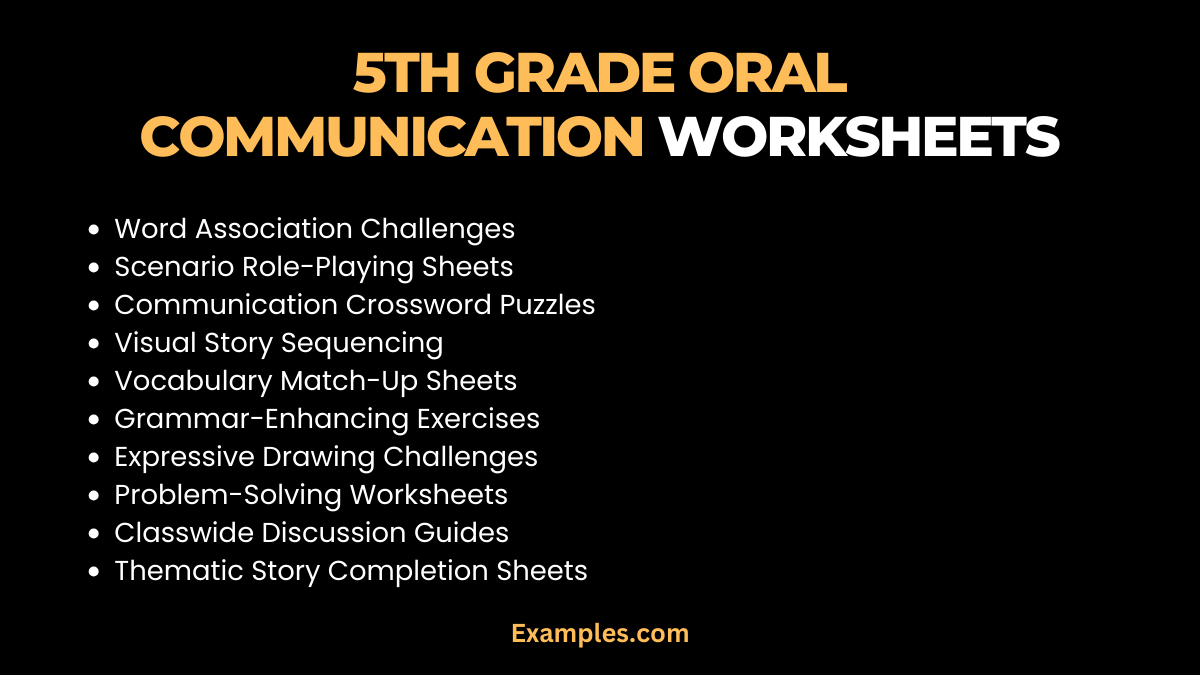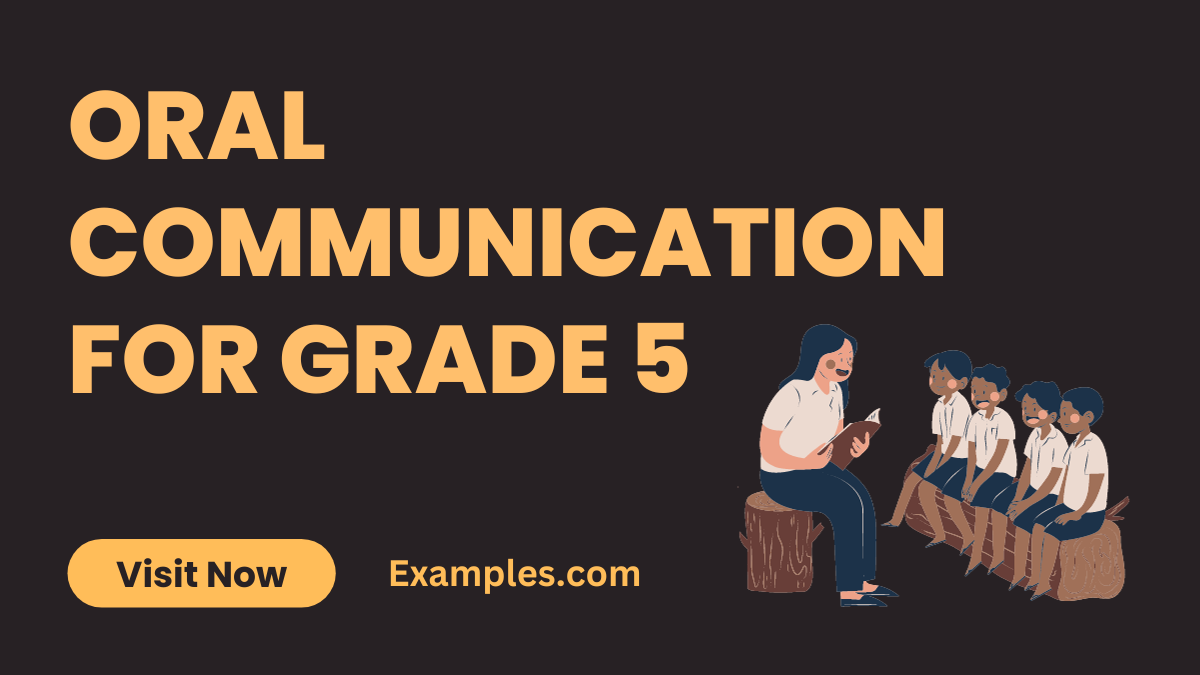29+ Oral Communication for Grade 5 Examples
Unlock the full potential of Oral Communication for Grade 5 with our comprehensive guide. From learning activities and strategies to worksheets that enhance communication skills, we’ve curated a rich resource for educators and parents alike. Dive into a world where effective communication is nurtured through interactive examples, making the learning journey engaging and impactful. Explore this complete guide, packed with insights, tips, and Communication Examples to empower 5th graders in their communication journey
What is Oral Communication for Grade 5?

Oral Communication for Grade 5 refers to the process of conveying information verbally among fifth-grade students. In simple terms, it involves spoken interactions, discussions, and expression of ideas. This crucial skill encompasses various learning activities and strategies tailored to enhance communication proficiency in the classroom setting. As students engage in verbal exchanges, they develop vital communication skills that contribute to their overall academic and personal growth.
Best Example of Oral Communication for Grade 5
One outstanding example of Oral Communication for Grade 5 is structured group discussions. In this activity, students participate in organized conversations, expressing their thoughts and actively listening to their peers. The goal is to cultivate interpersonal communication skills, encouraging students to articulate ideas, ask questions, and respectfully respond to others. This interactive example not only fosters effective communication but also promotes critical thinking, collaboration, and a supportive classroom environment for fifth-grade learners.
30 Oral Communication for Grade 5 Examples

Delve into a diverse array of 30 Oral Communication examples tailored for Grade 5 students. Each example serves as a building block for honing communication skills in a fun and engaging manner. From group discussions to role-playing scenarios, these activities foster a dynamic learning environment.
- Expressive Storytelling: Share a personal experience or imaginative tale to enhance narrative skills.
- Collaborative Class Debates: Engage in structured debates, promoting critical thinking and persuasive communication.
- Interactive Show-and-Tell: Develop descriptive skills by presenting personal objects to classmates.
- Thoughtful Peer Interviews: Conduct interviews with classmates, refining questioning and listening skills.
- Role-Playing Scenarios: Act out various situations to encourage empathy and effective communication.
- Creative Puppet Presentations: Use puppets to communicate ideas, fostering creativity and public speaking.
- Collaborative Story Building: Work together to create a story, enhancing teamwork and verbal expression.
- Mystery Bag Descriptions: Describe hidden objects in a bag, refining observational and descriptive language.
- Problem-Solving Brainstorm: Engage in group discussions to find solutions, promoting teamwork and communication.
- Picture-Based Story Prompts: Develop storytelling skills by creating narratives based on given images.
- Expressing Feelings through Art: Communicate emotions by creating artwork and explaining the inspiration behind it.
- Classwide Vocabulary Quiz: Foster word usage and understanding through friendly vocabulary competitions.
- News Reporter Simulations: Take turns reporting class news, enhancing reporting and presentation skills.
- Story Chain Game: Contribute to a collective story, reinforcing sequential communication and listening.
- Picture Dictation Exercise: Strengthen listening and instruction-following skills through this visual communication task.
- Charades for Vocabulary: Act out words without speaking, encouraging nonverbal communication.
- Comic Strip Creations: Develop sequential storytelling skills through the creation of comic strips.
- Jigsaw Puzzle Collaboration: Communicate effectively to solve puzzles as a team, enhancing cooperation.
- Classroom Radio Show: Host a radio-style show, improving articulation and broadcasting skills.
- Geography Mystery Skype: Communicate with another class globally, fostering cultural exchange and communication.
- Interactive Science Presentations: Share findings through hands-on science presentations, enhancing scientific communication.
- Math Problem-Solving Discussions: Collaboratively solve math problems, strengthening verbal reasoning skills.
- Classwide Book Reviews: Share thoughts on books, promoting literacy and discussion skills.
- Effective Classroom Announcements: Take turns making announcements, refining public speaking and clarity.
- Comparative Venn Diagrams: Communicate similarities and differences using visual aids.
- Constructive Peer Feedback Sessions: Provide and receive feedback on presentations, honing constructive communication.
- Nature Observation Narratives: Share observations from outdoor activities, connecting communication with the environment.
- Digital Storytelling Projects: Use technology to create multimedia stories, integrating digital communication skills.
- Classroom Survey and Analysis: Collect and present survey data, enhancing data interpretation and reporting.
- Musical Expression Performances: Communicate emotions through music, fostering creativity and emotional intelligence.
Oral Communication for Learning Activities Grade 5
Unlock a world of engaging learning activities designed to enrich oral communication for Grade 5 students. From interactive games to collaborative projects, these activities aim to enhance verbal expression, active listening, and overall communication proficiency. Explore a dynamic approach to communication that transcends traditional methods, making the learning experience both educational and enjoyable.
- Interactive Vocabulary Bingo: Engage in a lively bingo game using academic vocabulary to boost communication skills.
- Storytelling Circle: Form a circle, each student contributing a sentence to collaboratively create a unique story.
- Artistic Expression Showcase: Communicate thoughts and ideas through artistic projects, enhancing visual and verbal expression.
- Science Experiment Reporting: Practice clear and concise communication by presenting findings from science experiments.
- Math Problem-Solving Collaborations: Foster communication through group discussions to solve challenging math problems.
- Geography Inquiry Presentations: Research and present findings about different geographical regions, promoting comprehensive communication.
- Literature Circle Discussions: Engage in focused discussions about literature, fostering critical thinking and articulate expression.
- Digital Story Mapping: Utilize technology to create interactive story maps, integrating digital communication skills.
- Peer Interview Podcasts: Conduct and record interviews with classmates, refining questioning and listening abilities.
- Creative Presentation Showcase: Each student presents a unique project, showcasing individual communication styles and creativity.
Unlock the power of assessing communication skills with the Oral Communication Rubric designed for fifth-grade students. This tool provides a systematic approach to evaluating verbal proficiency, offering valuable insights into areas of strength and improvement. Utilize this guide to foster growth in expressive abilities, preparing students for effective communication in various contexts.
- Clear Articulation: Present a short, bold sentence clearly, demonstrating proper pronunciation and enunciation.
- Engaging Eye Contact: Maintain eye contact while speaking, connecting with the audience and conveying confidence.
- Effective Use of Volume: Deliver a message at varying volumes, showcasing control and adaptability in communication.
- Appropriate Pacing: Communicate a thought at a moderate pace, ensuring comprehension and engagement.
- Vivid Vocabulary Display: Incorporate rich vocabulary into a brief description, enhancing language expression.
- Expressive Facial Expressions: Convey emotions using facial expressions while communicating a simple narrative.
- Active Listening Skills: Demonstrate attentive listening through thoughtful responses to a peer’s statement.
- Constructive Feedback Delivery: Provide feedback on a given topic, emphasizing positivity and improvement areas.
- Nonverbal Communication Mastery: Convey a message using only nonverbal cues, showcasing the importance of body language.
- Spontaneous Story Creation: Craft a short story on the spot, displaying creativity and quick-thinking in communication
5th Grade Oral Communication Worksheets

Elevate oral communication skills with purposeful worksheets designed for fifth-grade students. These interactive learning tools cover a range of topics, from vocabulary building to scenario-based exercises, providing a structured approach to enhancing communication proficiency. Explore the curated selection of worksheets that make learning effective and enjoyable for Grade 5 students.
- Word Association Challenges: Connect words through associations, fostering quick and expressive verbal responses.
- Scenario Role-Playing Sheets: Engage in role-playing scenarios to practice effective communication in various situations.
- Communication Crossword Puzzles: Combine learning and fun with crossword puzzles that reinforce key communication concepts.
- Visual Story Sequencing: Arrange visual cues to create a cohesive story, enhancing storytelling and sequential communication.
- Vocabulary Match-Up Sheets: Match vocabulary words with their meanings, promoting language precision and understanding.
- Grammar-Enhancing Exercises: Integrate grammar-focused exercises into communication practice for comprehensive language development.
- Expressive Drawing Challenges: Communicate ideas through drawings, enhancing visual expression and creative communication.
- Problem-Solving Worksheets: Tackle real-world problems through written and verbal communication, promoting critical thinking.
- Classwide Discussion Guides: Use structured guides to facilitate discussions, encouraging participation and effective communication.
- Thematic Story Completion Sheets: Complete thematic stories individually or collaboratively, promoting creative verbal expression.
How to Improve 5th Grade Oral Communication Skills in the Classroom?
Enhancing oral communication skills in fifth-grade students is pivotal for their academic and personal development. This comprehensive guide provides actionable strategies for educators and parents to create an environment that nurtures effective communication in the classroom.
- Interactive Learning Activities: Foster engagement through interactive games, storytelling circles, and collaborative projects. These activities encourage verbal expression, active listening, and teamwork.
- Themed Discussions and Debates: Introduce themed discussions and debates, allowing students to express opinions, refine articulation, and develop persuasive communication skills.
- Role-Playing Scenarios: Incorporate role-playing scenarios to simulate real-life situations, helping students practice effective communication in various contexts.
- Technology Integration: Embrace technology with online platforms, multimedia presentations, and digital storytelling to enhance digital communication skills.
- Visual Aids and Storytelling: Utilize visual aids and storytelling techniques to make lessons more engaging, promoting effective communication and comprehension.
- Mindful Communication Practices: Integrate mindfulness exercises to enhance focus, attentiveness, and self-awareness during verbal exchanges.
- Structured Group Projects: Assign structured group projects that require collaboration, communication, and presentation skills, fostering teamwork.
- Vocabulary-Building Activities: Include word association challenges, crossword puzzles, and vocabulary match-up sheets to strengthen language precision.
- Reflective Journaling: Encourage students to reflect on their communication experiences through journaling, promoting self-awareness and improvement.
- Community Engagement: Connect classroom learning to real-world scenarios through community outreach projects, encouraging effective communication in authentic settings.
it’s crucial to integrate external resources that offer further insights and tools to support the development of communication skills in children.American Speech-Language-Hearing Association (ASHA): ASHA provides a wealth of information on children’s communication development, including practical tips and resources for parents and educators. Their guide on “Your Child’s Communication Development: Kindergarten Through Fifth Grade” is an excellent resource for understanding the nuances of communication skills at different ages. You can find more information at ASHA’s official website??. Johns Hopkins Medicine Known for its expertise in child health and development, Johns Hopkins offers guidance on “Communication and Your 4-to-5-Year-Old.” This resource can be particularly useful for parents and educators in understanding and fostering effective communication skills in children. Visit Johns Hopkins Medicine’s page for more details??.



